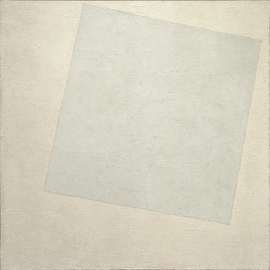White on White
This article needs additional citations for verification. (January 2022) |
| White on White | |
|---|---|
 | |
| Artist | Kazimir Malevich |
| Year | 1918 |
| Catalogue | 80385 |
| Medium | Oil on canvas |
| Dimensions | 79.4 cm × 79.4 cm (31¼ in × 31¼ in) |
| Location | Museum of Modern Art, New York City[1] |
| Accession | 817.1935 |
Suprematist Composition: White on White (1918) is an abstract oil-on-canvas painting by Kazimir Malevich. It is one of the more well-known examples of the Russian Suprematism movement, painted the year after the October Revolution.
Part of a series of "white on white" works begun by Malevich in 1916, the work depicts a white square, portrayed off-centre and at an angle on a ground which is also a white square of a slightly warmer tone. The work measures 79.5 by 79.5 centimetres (31.3 in × 31.3 in). Malevich dispenses with most of the characteristics of
A critic from the rival Constructivist movement quipped that it was the only good canvas in an exhibition by Malevich's UNOVIS group: "an absolutely pure, white canvas with a very good prime coating. Something could be done on it."
Malevich took the work to
See also
- Black Square(1915)
References
- ^ "Suprematist Composition: White on White". Museum of Modern Art. Retrieved 2012-08-19.
External links
- Suprematist Composition: White on White (1918), Alexandra Sokolova
